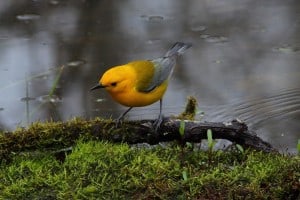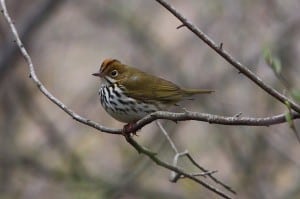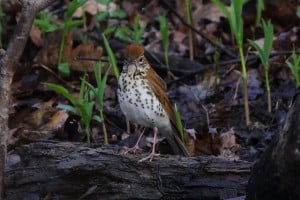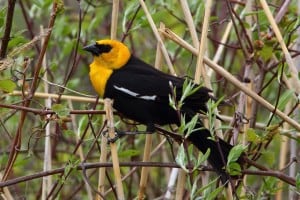There are few better places to enjoy the beauty of a southern Ontario spring than the woodland trails of Rondeau Provincial Park. Winding through Carolinian forests blanketed with ferns and spring wildflowers, the trails routinely provide close-up views of some of our most spectacular birds. This year, the honours went to the Prothonotary Warbler. On two different occasions, we watched this rare Ontario species only metres away as it searched for food on the flooded forest floor of the Tulip Tree Trail. Its brilliant orange-yellow head and blue-gray wings produced a non-stop chorus of oohs and awes from the appreciative birders. Photographers had a field day as they clicked off one stunning picture after another.
Last week, Jim Cashmore, Mitch Brownstein, Greg Piasetzki and I made our annual pilgrimage to the southern Ontario birding meccas of Rondeau Provincial Park and Point Pelee National Park. These two wooded peninsulas that jut out into Lake Erie concentrate thousands of migrant birds in the spring. For anyone wanting to see North America’s most spectacular spring migrants – Scarlet Tanagers, Baltimore Orioles, Red-breasted Grosbeaks and more than two dozen species of warbler – a trip, Rondeau and Pelee is a must.
The birding this year was good with an almost constant parade of interesting species to be seen. Cool temperatures and winds from the north meant that many migrants lingered in the parks for several days instead of immediately pursuing their journey northward. The cool weather also meant that the leaves were not yet out, so seeing the birds was easier than it is some years. Thrushes and flycatchers were present in especially good numbers, as were Scarlet Tanagers. There was also an ample selection of warblers, ranging from early migrants like Yellow-rumped and Palm to species that tend to arrive later such as the Canada and Mourning warblers. By week’s end, we had managed to find about 130 different kinds of birds, 25 of which were warblers.
For many birders, spring birding is very much about sound. By focusing your attention on bird song, you get an almost instantaneous picture of the diversity of species around you as well as the number of individual birds. This past week, the dominant voices included Baltimore Orioles, Yellow Warblers, House Wrens and Rose-breasted Grosbeaks. Not quite as common, but calling at least every couple of minutes were Least Flycatchers, Eastern Wood‑pewees, Eastern Towhees, Tree Swallows, Wood Thrushes, Blue-gray Gnatcatchers and Magnolia Warblers. The challenge, however, is to coax your brain to push these more common sounds into the background, so that the voices of less common species can be detected.
Many iconic bird sounds belong to the night. Just after sunset one evening, we drove over to a field across from the Rondeau visitors centre. As we rolled down the car windows, the peenting calls of American Woodcocks stood out clearly against a background chorus of Spring Peepers. Almost immediately, we saw one of several woodcocks launch itself into the air, its wings producing a quivering sound as it gained altitude. Soon, we could see its silhouette against the pale pink light of the darkening sky – an iconic image of spring nights that I never tire of seeing. But that wasn’t all. Moments later, a Common Nighthawk flew by, coursing over the field like a giant moth and making a rasping nasal buzz. Finally, the quintessential species of spring and summer nights added its voice to the mix as we drove down to the South Point Trail. Even with the car windows up, it was impossible to miss the loud, repetitive call of the Whip-poor-will.
Point Pelee
On Wednesday morning, we decided to make the one-hour drive west to Point Pelee. Like Rondeau, Pelee is home to Ontario’s Carolinian forest, a habitat type that has almost disappeared from the province. The Pelee woods are dominated by Hackberry Trees and vines such as Wild Grape, Virginia Creeper and Poison Ivy. In May, the forest floor is a carpet of Sweet Cicely, Wild Columbine and Wild Geranium. As you can imagine, the air smells wonderful.
Having four pairs of eyes proved to be very handy this particular morning. Even at the parking lot, a constant parade of thrushes, orioles, warblers and tanagers moved past us, flying quickly from tree to tree and often at eye level. We eventually made our way out to the tip area and joined the throng of birders already there. Standing shoulder to shoulder on the boardwalk, we were immersed in a see of binoculars, scopes and colossal cameras. The somewhat crowded conditions were soon forgotten, however, thanks to the constant bird activity. Over the next couple of hours, we added a variety of new warblers such as the Blackpoll and Cape May, the Philadelphia Vireo and both Black-billed and Yellow-billed Cuckoo. We also ran into two other Peterborough birders, namely Jerry Ball and Clayton Vardy. Jerry had been at Pelee for two weeks and had seen no less than 208 species, while Clayton was already up to 24 warbler species for the day!
After taking a break at the park visitors centre – there are naturalists on hand to answer questions, a great bookstore and the Friends of Point Pelee provide a delicious hot lunch – we walked the Tilden’s Woods trail and a section of the park where a Kentucky Warbler had been seen. Although we didn’t find the Kentucky, large numbers of other warblers made up for its absence, including one flock with at least four Northern Parulas. We wrapped up the day with a trip north of Point Pelee to Hillman Marsh to see ducks, gulls and shorebirds. The highlights there were a Red-necked Phalarope and a Willet.
Despite the rather crowded conditions on some of the trails at Pelee, respect for the birds and courtesy for fellow birders are always very noticeable. Rarely do people speak in a loud voice or push their way past others. Most birders are ready to help beginners with identification problems, as well, and to share the location of sought-after species. However, it is hard not to notice that there are very few young people. The vast majority of birders we see each year are probably 60 or older. Because birders ‑ and naturalists in general ‑ are usually committed conservationists who represent a strong voice for the protection of species and wild spaces , one cannot help but wonder what the lack of younger people means for the future.
Thursday was cold and wet, so rather than spending the day at Rondeau, we drove north to Mitchell’s Bay on Lake St. Clair. The marsh here is well known for a small colony of Yellow-headed Blackbirds, a species usually not found in Ontario. For a photographer like Greg, this outrageously coloured blackbird made for a delightful subject. The six males we found were anything but shy, as they focused all of their attention on courting the half-hidden females. The raucous wail the males made could only be described as something between a braying donkey and a piercing chainsaw. On our way back to the Park, we stopped at the Blenheim sewage lagoon, where we were greeted by the remarkable sight of thousands of swallows coursing over the lagoons and nearby fields as they snatched up tiny flies called midges. The lagoons also offered up Ruddy Ducks, Bobolinks, Savannah Sparrows and Eastern Meadowlarks, all of which are hard to find in this part of the province.
By week’s end, the greater number of female warblers – females migrate later than males – and the arrival of late migrants such as the Eastern Wood-pewee and Mourning Warbler were signs that spring’s passage of northbound birds is drawing to a close. The season of migration is now giving way to the season of nesting. However, the change of season holds the promise of bountiful young birds that will commence their own journey – southward this time – in just a few short months.



